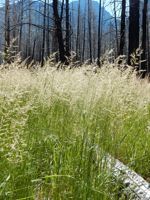Mon-Fri 9am - 5pm Mountain time
Upright Prairie Coneflower vs Bluejoint
Ratibida columnifera
Calamagrostis canadensis
NOT AVAILABLE THIS SEASON - MIGHT RETURN
CUSTOM GROW
Upright Prairie Coneflower is a native perennial wildflower known for its vibrant flowers, which range from golden yellow to dark rust-red with yellow edges. Rising on tall, slender stems, the flowers’ drooping petals surround a central cone. They bloom from midsummer into fall, attracting butterflies, bees, and other pollinators. After blooming, the florets on the cone eventually develop into seeds, which provide a food source for birds.
Its upright growth habit allows it to grow in clusters, creating a striking display. Due to its deep taproot, Upright Prairie Coneflower is drought tolerant, making it well suited to dry areas and xeriscape gardens. Low-maintenance and deer-resistant, this wildflower is a great choice for adding vibrant color and ecological value to any landscape.
Bluejoint is a native perennial grass that forms tall, dense colonies. It is one of the most abundant grasses found in Canada and the United States. The extensive shallow root system and spreading rhizomes help stabilise soils, especially in wet meadows, marshes, and along streambanks.
It is a cool-season grass, growing most actively in spring and fall and slowing during the heat of summer. Seeds from its purple-tinged spikes feed birds and small mammals, and the plant itself provides forage for wildlife and livestock, though it does not tolerate heavy grazing. Its tall, dense growth also offers nesting habitat for wetland birds. With these combined values, Bluejoint is well-suited for naturalisation, riparian plantings, and habitat restoration projects.

